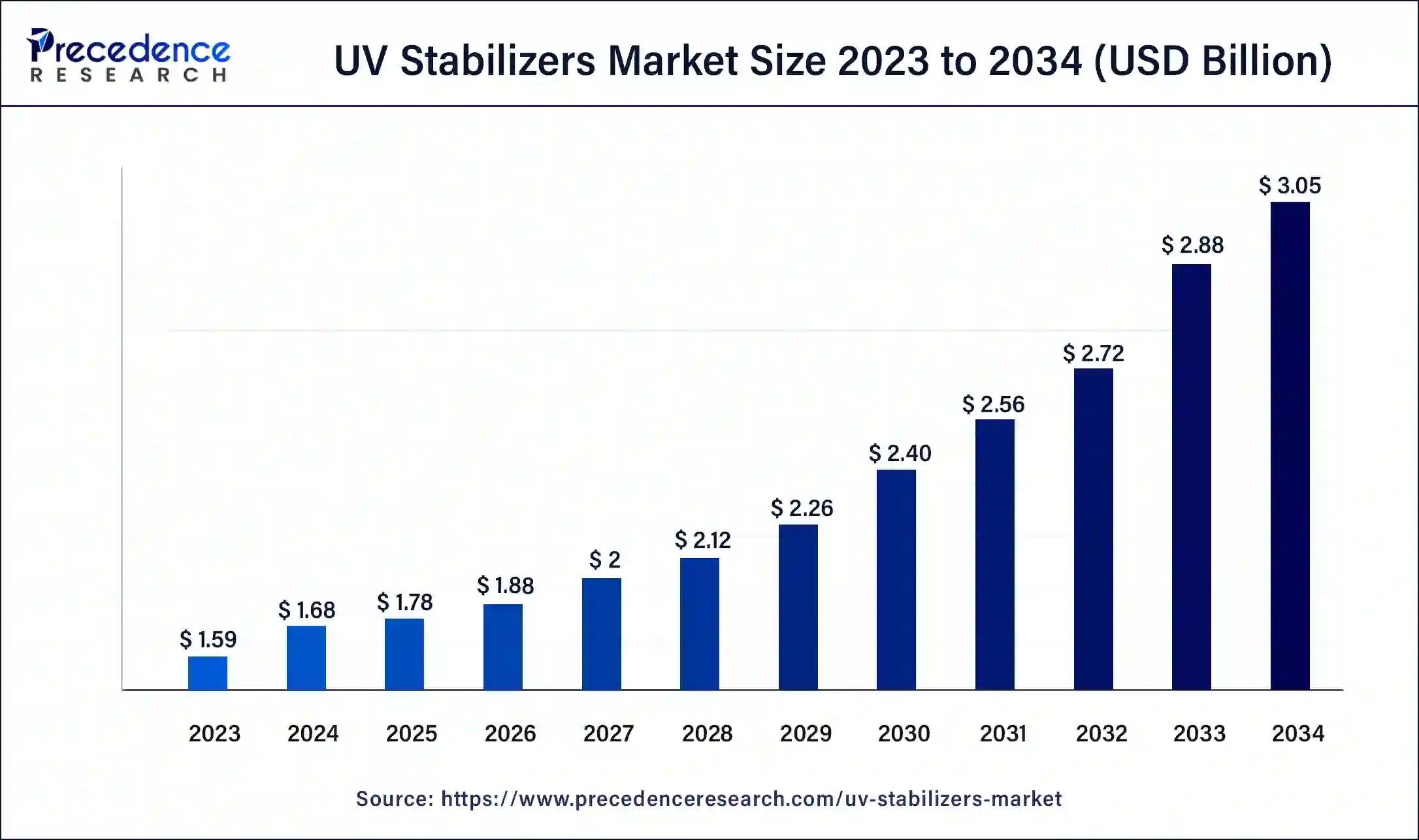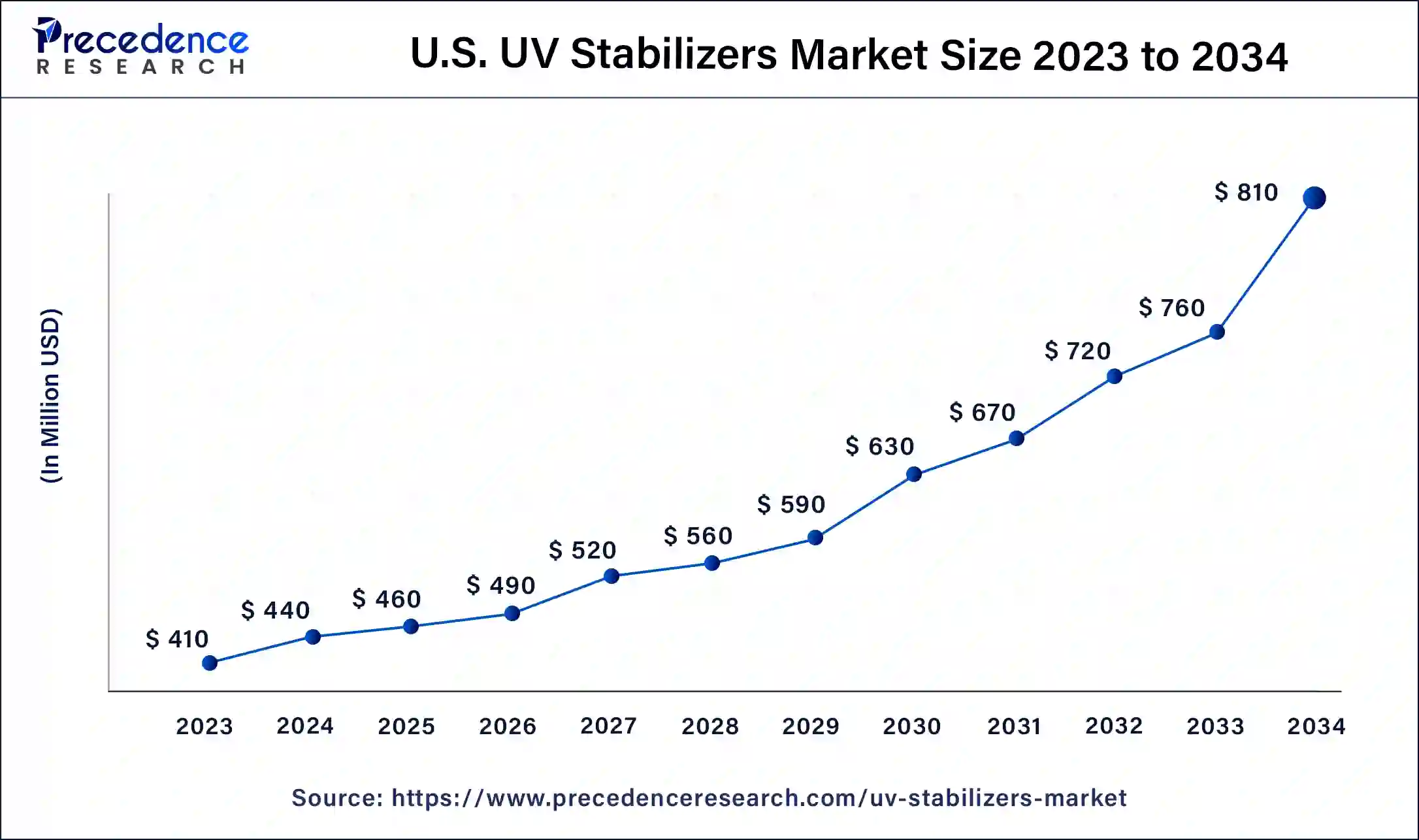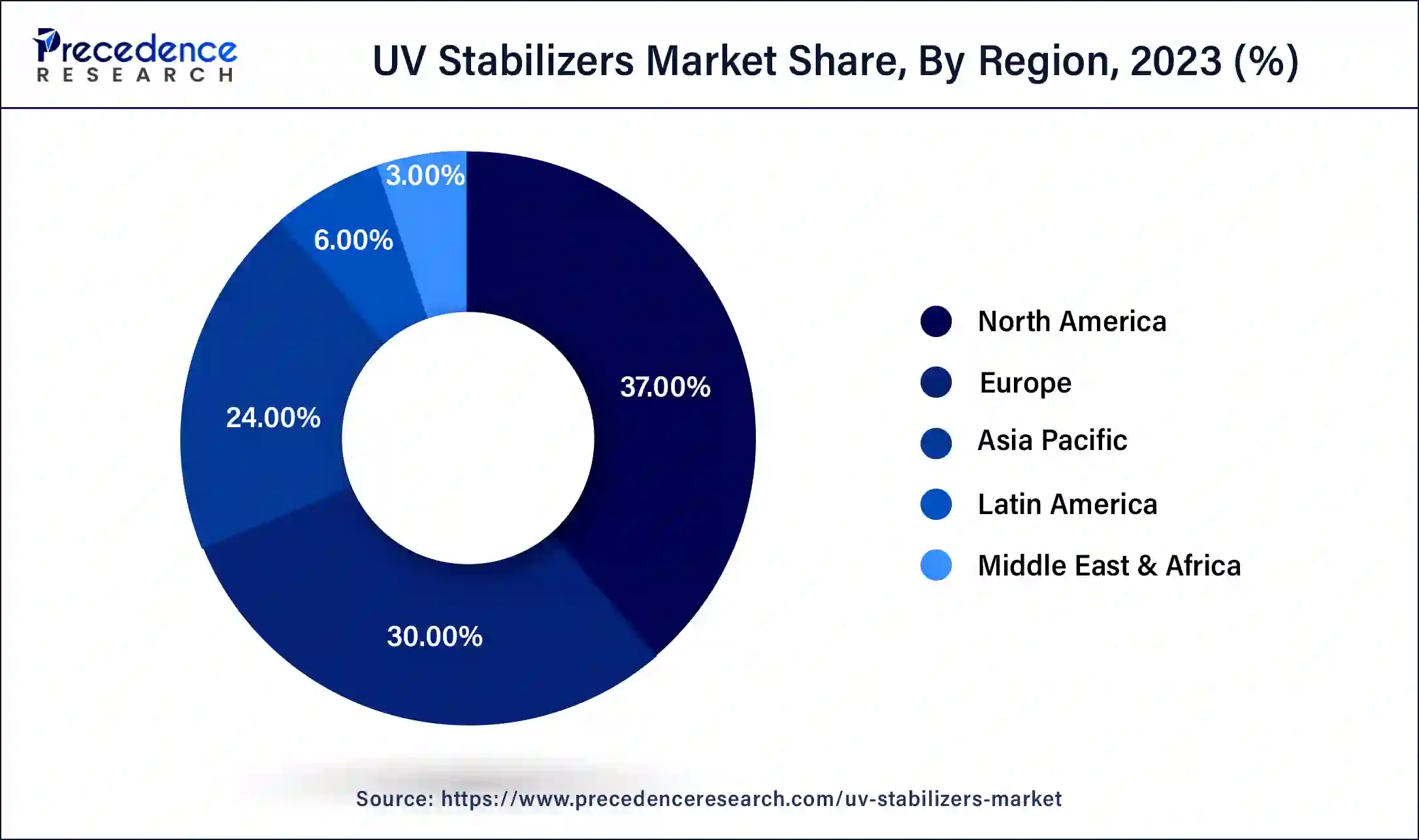UV Stabilizers Market (By Type: UV Absorbers, Hindered Amine Light Stabilizers, Quenchers, Antioxidants, Others; By End-User Industry: Packaging, Automotive, Agriculture, Building and Construction, Adhesives and Sealants, Other End-User Industries) - Global Industry Analysis, Size, Share, Growth, Trends, Regional Outlook, and Forecast 2024-2034
The global UV stabilizers market size was USD 1.59 billion in 2023, calculated at USD 1.68 billion in 2024, and is expected to reach around USD 3.05 billion by 2034, expanding at a CAGR of 6.16% from 2024 to 2034. The North America UV stabilizers market size reached USD 590 million in 2023.

The U.S. UV stabilizers market size was valued at USD 410 million in 2023 and is expected to reach USD 810 million by 2034, growing at a CAGR of 6.29% from 2024 to 2034.

North America has held the largest revenue share of 37% in 2023. In North America, the UV stabilizers market is witnessing a trend towards sustainability and regulatory compliance. Industries are progressively adopting eco-friendly UV stabilizers to align with environmental regulations and consumer demand for greener products. Additionally, the construction and automotive sectors are experiencing a surge in demand for UV stabilizers, primarily for enhancing the durability and aesthetics of materials and products exposed to sunlight.

Asia-Pacific is estimated to observe the fastest expansion. In the Asia-Pacific region, the UV stabilizers market is expanding rapidly, driven by robust industrial growth and the rising popularity of outdoor products. The region is experiencing an increasing need for UV-resistant materials, especially in construction and agriculture. Furthermore, there is a noticeable shift towards sustainable UV stabilizer solutions in line with global environmental concerns, fostering market growth and innovation.
In the European UV stabilizers market, a strong emphasis is placed on sustainability and innovation. Industries are increasingly adopting eco-friendly UV stabilizer formulations to meet stringent environmental regulations and cater to a conscientious consumer base. Ongoing research and development efforts in the region contribute to advanced UV stabilizer technologies that offer improved UV protection and versatility, addressing the evolving needs of various sectors such as construction and automotive, making Europe a dynamic hub in the UV stabilizers market.
| Report Coverage | Details |
| Market Size by 2034 | USD 3.05 Billion |
| Market Size in 2023 | USD 1.59 Billion |
| Market Size in 2024 | USD 1.68 Billion |
| Growth Rate from 2024 to 2034 | CAGR of 6.16% |
| Largest Market | North America |
| Base Year | 2023 |
| Forecast Period | 2024 to 2034 |
| Segments Covered | Type, By End-User, Region |
| Regions Covered | North America, Europe, Asia-Pacific, Latin America, and Middle East & Africa |
UV-resistant packaging and expanding end-use industries
The growing demand for UV-resistant packaging is a significant driver of the UV stabilizers market. UV radiation from sunlight can degrade and discolor packaging materials, compromising the quality and appearance of the contents. This is especially crucial in the food and beverage industry, where product integrity and consumer perception are paramount. UV stabilizers offer a solution by preventing UV-induced damage to the packaging, extending the shelf life of products, and maintaining their visual appeal during storage and transportation. As consumers continue to demand fresher and more sustainable packaging solutions, the need for UV-resistant materials is on the rise, driving market growth.
The UV stabilizers market is propelled by the expanding use of UV-resistant materials in various industries. Sectors like construction, automotive, agriculture, and packaging rely on UV-stabilized materials to enhance the durability and aesthetics of their products. In construction, UV stabilizers help protect building materials from sunlight, while the automotive industry employs them to maintain the appearance and longevity of vehicle components. The agricultural sector uses UV-resistant materials to extend the lifespan of outdoor equipment. As these industries continue to grow and evolve, the demand for UV stabilizers to ensure the reliability and visual appeal of their products increases, thereby surging market demand for UV stabilizers.
Volatility in raw material prices and regulatory compliance
The UV stabilizers market faces a restraint in the form of fluctuating raw material prices. The cost of essential components used in UV stabilizer formulations, such as chemicals and additives, can be unpredictable. These price fluctuations can directly impact the manufacturing cost of UV stabilizers, making it challenging for producers to maintain competitive pricing. This, in turn, can deter potential buyers from investing in UV stabilizers, as they may seek more cost-effective solutions or delay their purchase decisions. The uncertainty regarding raw material costs creates an environment of economic instability, influencing market demand and potentially limiting the growth of the UV stabilizers industry.
Regulatory compliance is another constraint in the UV stabilizers market. Governments and environmental agencies continue to impose strict regulations on chemicals used in various industries, including UV stabilizers. Compliance with evolving environmental standards and safety regulations can place a significant burden on UV stabilizer manufacturers. This may translate into elevated production costs, which are frequently transferred to consumers in the form of higher prices.
Furthermore, navigating through regulatory complexities can introduce delays in product development and market entry, potentially impeding the growth of UV stabilizer manufacturers. Buyers may opt for alternatives that face fewer compliance challenges or seek eco-friendly solutions, affecting the market demand for traditional UV stabilizers. Thus, regulatory compliance requirements can restrict market growth and create obstacles for UV stabilizer suppliers.
Sustainable formulations, research and development
A strong emphasis on sustainability increasingly influences the market demand for UV stabilizers. As environmental consciousness grows, there is a notable shift towards sustainable formulations of UV stabilizers with minimal ecological impact. Consumers, industries, and governments favor eco-friendly and biodegradable UV stabilizer alternatives. This shift towards sustainability not only ensures compliance with stringent environmental regulations but also aligns with broader industry trends. Manufacturers who invest in the development of greener UV stabilizers capitalize on this growing demand, catering to a market that seeks effective yet environmentally responsible solutions.
Continuous research and development efforts significantly drive market demand. The UV stabilizers market is dynamic, with a constant need for improved performance and more cost-effective solutions. Ongoing R&D initiatives lead to the creation of advanced UV stabilizer technologies that offer better UV protection, enhanced efficiency, and versatility. Innovation in this field enables UV stabilizers to address the evolving requirements of various industries, making them indispensable for UV protection in a wide range of applications. The market thrives on innovation and product advancement, with research and development serving as a powerful catalyst for sustained growth.
The UV absorbers has held 41% revenue share in 2023. UV absorbers are UV stabilizers that function by absorbing UV radiation and converting it into harmless heat. UV absorbers find common usage in various materials, including plastics and coatings, to shield against UV-induced deterioration and color changes. Within the UV stabilizers market, a prominent trend is the growing preference for UV absorbers offering improved efficiency and a reduced environmental footprint.
Manufacturers are actively working on UV absorbers that deliver enhanced UV protection while meeting sustainability objectives and complying with environmental regulations. Manufacturers focus on developing eco-friendly UV absorbers that provide superior UV protection while aligning with sustainability goals and regulatory requirements.
The Hindered amine light stabilizers (HALS)segment is anticipated to expand at a significant CAGR of 7.5% during the projected period. Hindered amine light stabilizers (HALS) are another category of UV stabilizers. They work by preventing the degradation of polymers and plastics when exposed to UV radiation. A significant trend in this segment is the development of HALS with extended durability, allowing materials to withstand prolonged UV exposure without losing their structural integrity. Additionally, HALS that can be easily incorporated into various formulations are gaining popularity, enhancing their versatility in different applications, such as automotive coatings and outdoor furniture.
Based on the end use industry, packaging is anticipated to hold the largest market share of 38% in 2023. In the UV stabilizers market, the packaging industry is a significant end-user. UV stabilizers are essential in packaging materials like plastics, ensuring the packaging remains visually appealing and structurally sound during storage and transportation. A prominent trend in this sector is the increasing demand for UV-resistant packaging materials, particularly in the food and beverage industry, to maintain product quality and extend shelf life. Manufacturers are focusing on developing UV stabilizers tailored for specific packaging applications to meet the industry's evolving needs.
The automotive segment is projected to grow at the fastest rate over the projected period. The automotive sector relies on UV stabilizers to protect various vehicle components from UV radiation, including interior materials and coatings. A notable trend in this industry is the use of UV-stabilized materials to maintain the appearance and durability of automotive components exposed to sunlight. As automotive designs increasingly incorporate plastics, there is a growing demand for UV stabilizers to ensure these materials withstand UV exposure, contributing to vehicle longevity and aesthetics. The automotive industry continues to be a key driver in the UV stabilizers market.
By Type
By End-User Industry
By Geography
For inquiries regarding discounts, bulk purchases, or customization requests, please contact us at sales@precedenceresearch.com
No cookie-cutter, only authentic analysis – take the 1st step to become a Precedence Research client